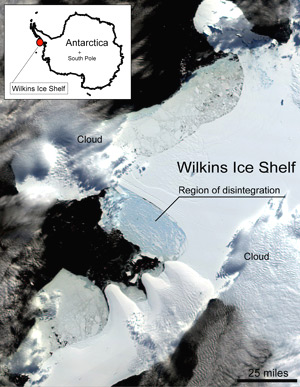| |
| |

Antarctic ice shelf disintegration
25 March 2008
National Snow and Ice Data Center (NSIDC), British Antarctic Survey (BAS), and Earth Dynamic System Research Center, National Cheng Kung University
Satellite images reveal that a 13,680 sq.km (5,282 sq.mile) ice shelf has begun to collapse because of rapid climate change in a fast-warming region of Antarctica.
The Wilkins Ice Shelf is a plate of permanent floating ice on the southwest Antarctic Peninsula. The western Antarctic Peninsula has had the biggest temperature increase on Earth in the last 50 years, rising 0.5°C (0.9 °F) each decade.
NSIDC Lead Scientist Ted Scambos, who first spotted the disintegration in March, said, "We believe the Wilkins has been in place for at least a few hundred years. But warm air and exposure to ocean waves are causing a break-up." |
|
| |
 |
| |
This latest ice shelf collapse is a strong indication that global warming is changing Antarctic ice faster than prevously predicted. |
|
| |
 |
| |
|
The Wilkins Ice Shelf began its collapse on February 28th when a large iceberg, 41 by 2.5 kilometers (25.5 by 1.5 miles), fell away from the southwestern front, triggering a runaway disintegration of 570 sq.km (220 sq.miles) of the shelf interior (images right).
The edge of the shelf crumbled into the sky-blue pattern of exposed deep glacial ice that has become characteristic of climate-induced ice shelf break-ups such as the Larsen B in 2002. (image centre right)
A narrow beam of intact ice, just 6 km (3.7 miles) wide was protecting the remaining shelf from further breakup as of March 23 (image bottom right and below).
|
| |
 |
| |
Image: National Snow and Ice Data Center (NSIDC)
 View larger image View larger image |
 |
| |
Ice shelves hold back glaciers, which if unleashed, can accelerate and raise sea level. Scambos said, "The Wilkins disintegration won't raise sea level because it already floats in the ocean, and few glaciers flow into it."
"However, the collapse underscores that the Wilkins region has experienced an intense melt season. Regional sea ice has all but vanished, leaving the ice shelf exposed to the action of waves."
With Antarctica's summer melt season drawing to a close, scientists do not expect the Wilkins to further disintegrate in the next several months. "This unusual show is over for this season," Scambos said. |
| |
|
|


